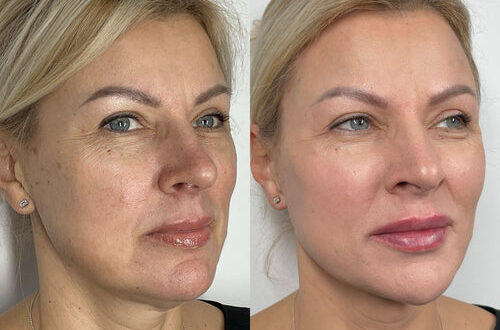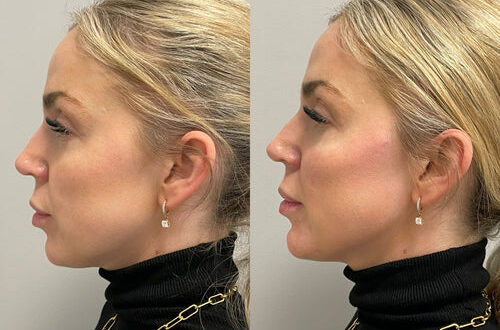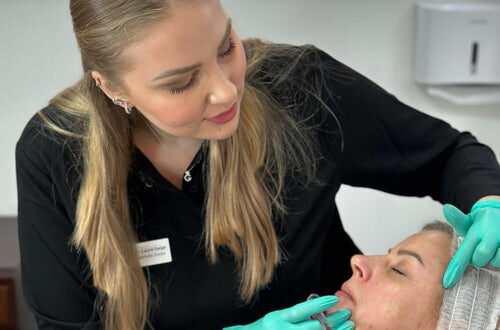Book a Dermal Filler Session with Dr. Laura Geige Today
Understanding Preauricular Sinuses
What are Preauricular Sinuses?
Preauricular sinuses are small, fluid-filled pockets or cysts that occur on the earlobe. They often present as a dimple or opening near the front of the ear.
These sinuses typically form during fetal development when tissues fail to close completely. The location directly relates to where the first and second pharyngeal arches meet in the developing embryo, giving them their characteristic placement.
While they are usually benign and don’t cause significant discomfort, preauricular sinuses can sometimes become infected or irritated.
Infection can lead to symptoms like pain, swelling, redness, and drainage. In some cases, the sinus may also develop a chronic infection that requires medical intervention.
Types of Preauricular Sinuses
Preauricular sinuses are small fistulas or pits located along the anterior aspect of the ear, just in front of the external auditory canal. These structures often appear as a dimple or small opening on the skin near the base of the helix.
Their exact etiology is unknown, but they are believed to be remnants of embryonic development. During fetal development, the first and second pharyngeal arches contribute to the formation of various structures in the head and neck, including the ear. Sometimes, these developmental pathways don’t close completely, resulting in preauricular sinuses.
While often asymptomatic, preauricular sinuses can occasionally cause problems such as:
– Infection: The sinus opening can become a portal for bacteria, leading to inflammation and infection of the surrounding tissues.
– Recurring infections: Chronic infections in these areas can create recurrent issues.
– Cosmetic concerns: Some individuals may find the appearance of preauricular sinuses aesthetically displeasing.
Types of Preauricular Sinuses
Preauricular sinuses are classified based on their anatomical features and potential for complications:
-
Simple Sinus: The most common type, characterized by a small opening that may or may not be associated with a subcutaneous tract.
-
Fistulous Sinus: This type involves a deeper, wider tract connecting the sinus to underlying tissues. It has a higher risk of infection and complications.
-
Branching or Complex Sinus: These sinuses have multiple openings or branches that extend into deeper tissues.
Treatment for preauricular sinuses typically focuses on addressing symptoms and preventing complications. Surgical excision is often recommended when the sinus causes recurrent infections, cosmetic concerns, or other functional issues.
Prevalence and Associated Concerns
Preauricular sinuses are small, pouch-like openings found just in front of the ear, along the upper cheekbone. These sinuses are a common congenital anomaly, meaning they are present at birth. Their exact cause is unknown but they are thought to result from incomplete development of the first and second branchial arches during fetal development.

The *prevalence* of preauricular sinuses varies widely depending on ethnicity. They are most common in people of **African** descent, followed by people of Asian descent. In European populations, they occur much less frequently.
Preauricular sinuses are usually small and asymptomatic, meaning they do not cause any pain or discomfort.
However, there are certain concerns associated with them:
-
* **Infection:** The openings of preauricular sinuses can become infected, leading to redness, swelling, pain, and discharge. This infection is known as a *preauricular sinus abscess*.
-
* **Cysts: ** Fluid-filled sacs called cysts may develop within the sinus tract. These cysts are usually harmless but can cause discomfort or become infected.
-
* **Dermatological Concerns:** Sometimes, preauricular sinuses can lead to skin problems such as acne or irritation due to increased sweating and oil production in the area.
In many cases, no treatment is necessary for preauricular sinuses. However, if they become infected or cause discomfort, a doctor may recommend:
Reserve a Dermal Filler Consultation with Dr. Laura Geige Now
-
* **Warm Compresses:** Applying warm compresses to the affected area can help reduce pain and swelling.
-
* **Antibiotics: ** If an infection is present, antibiotics will be prescribed to clear it up.
-
* **Surgical Removal: ** In some cases, especially if the sinus is causing recurrent infections or cosmetic concerns, surgical removal may be recommended.
Arrange a Dermal Filler Consultation at It’s Me and You Clinic with Dr. Laura Geige
Methods for Closing Preauricular Sinuses
Surgical Closure Techniques
Preauricular sinuses are congenital fistulas located on the anterior surface of the ear, typically presenting as small pits or tracts that can become infected and inflamed.
Surgical closure of these sinuses is a common procedure performed to alleviate symptoms and prevent recurrent infections. The choice of surgical technique depends on several factors, including the size and location of the sinus, as well as the surgeon’s experience and preference.
Excisional Closure:** This approach involves excising (cutting out) the entire preauricular sinus tract. After making an incision along the tract, the surrounding skin and tissues are dissected to remove the fistula completely. The wound is then closed with sutures or staples.
**Endoscopic Closure:**
A less invasive technique involves using a thin endoscope, a flexible tube with a camera attached, inserted into the sinus tract. This allows visualization of the entire length of the fistula and enables precise cauterization (burning) or laser ablation (destruction) of the lining tissues. The endoscopic approach minimizes scarring and reduces the risk of complications.
**Marsupialization:**
In cases where the sinus is particularly deep or complex, *marsupialization* may be considered. This technique involves creating a small opening (a “pocket”) at the end of the sinus tract. The lining tissues are then removed, and the pocket is left open to drain any secretions. A thin layer of skin flap is usually grafted over the opening to prevent infection.
**Importance of Follow-up Care:**
After surgical closure, patients typically require a course of antibiotics and pain medication. Regular follow-up appointments with the surgeon are essential to monitor wound healing, identify any potential complications, and ensure complete resolution of the preauricular sinus.
Non-Surgical Management Options
Preauricular sinuses are small, sac-like structures found in the ear’s front cartilage. They often cause no problems, but can become infected and painful.
Several methods exist for closing preauricular sinuses, including surgical and non-surgical options. This response will focus on non-surgical management techniques.
-
**Observation:** For asymptomatic or mildly symptomatic sinuses, close monitoring might be sufficient. If the sinus doesn’t show signs of infection or discomfort, it may not require intervention.
-
**Topical Antibiotic Ointment:** A healthcare professional can prescribe a topical antibiotic ointment to apply directly to the sinus opening. This can help prevent infection and reduce inflammation in case of mild symptoms.
-
**Warm Compresses:** Applying a warm compress to the affected area several times daily can promote drainage, soothe pain, and reduce swelling.
-
Oral Antibiotics: If a sinus infection develops, oral antibiotics may be prescribed by a doctor to fight the bacterial infection.
It’s important to note that non-surgical management techniques are usually effective for mild cases of preauricular sinuses. However, if symptoms persist or worsen despite these measures, surgical intervention may become necessary to ensure complete closure and prevent recurrent infections.
Post-Closure Care and Considerations
Expected Recovery Timeline
Post-closure care for preauricular sinus excision involves several crucial steps to ensure proper healing and prevent complications.
Initially, the surgical site will be bandaged to protect it and minimize bleeding. The patient should keep this dressing clean and dry, changing it as instructed by their doctor.
Gentle cleansing with mild soap and water is recommended for the surrounding area, avoiding any scrubbing or irritation of the wound.
Antibiotics prescribed by the surgeon should be taken exactly as directed to prevent infection.
Patients are typically advised to avoid activities that could strain the surgical site for several days. This includes strenuous exercise, heavy lifting, and prolonged bending over.
It’s essential to monitor the wound for signs of infection, such as redness, swelling, pain, warmth, or discharge.
If any of these symptoms arise, the patient should contact their doctor promptly.
The expected recovery timeline for preauricular sinus excision is generally short, with most patients experiencing significant improvement within a week.
However, complete healing can take several weeks or even months.
During this period, the incision line will gradually fade and become less noticeable.
It’s important to note that individual recovery times may vary depending on factors such as the size and complexity of the sinus, the patient’s overall health, and adherence to post-operative instructions.
Potential Complications and Risks
Post-Closure Care and Considerations:
After surgical closure of a preauricular sinus, proper wound care is crucial to ensure healing and minimize the risk of complications.
The patient should be instructed on how to keep the incision clean and dry. Gentle cleansing with mild soap and water may be recommended, followed by patting dry.
Avoid using harsh soaps or lotions that could irritate the wound.
The surgical dressing should be kept in place as directed by the surgeon.
The patient should avoid touching or picking at the incision site.
Over-the-counter pain medication can be used as needed to manage discomfort.
It is important for patients to follow their surgeon’s instructions regarding activity restrictions, as excessive movement or strenuous activity could interfere with healing.
Follow-up appointments are essential to monitor the progress of the healing process and address any concerns.
Potential Complications and Risks:
As with any surgical procedure, there are potential complications associated with preauricular sinus closure. These may include:
• *Infection*:
This is a common risk after surgery, particularly if proper wound care is not followed. Signs of infection include redness, swelling, pain, warmth, and discharge from the incision.
• *Bleeding*: Some bleeding may be expected after surgery, but excessive bleeding could occur.
• *Scarring*: All surgical incisions leave scars, but the extent of scarring can vary.
Factors such as wound healing abilities and individual genetics can influence scar formation.
• *Recurrence*:
In some cases, preauricular sinuses may recur even after successful closure. This may be due to incomplete removal of all sinus tissue or the natural tendency for these structures to develop.
• *Nerve Damage*: Although rare, there is a risk of nerve damage during surgery.
This could result in numbness or tingling sensations in the surrounding area.
• *Poor Wound Healing*:
Some individuals may experience difficulty with wound healing due to underlying medical conditions or medications they are taking.
It’s important for patients to discuss any pre-existing health concerns or medications with their surgeon before surgery.
Long-Term Outlook
Post-closure care for preauricular sinus closure surgery is crucial for ensuring a successful outcome and preventing complications. It involves a combination of wound care, medication management, and lifestyle modifications.
Here’s a detailed look at post-closure care considerations:
Wound Care:
-
Keep the surgical site clean and dry. Gently cleanse the area twice daily with mild soap and water.
-
Apply antibiotic ointment as directed by your surgeon to prevent infection.
-
Change dressings as instructed, usually every 1-2 days or sooner if they become wet or soiled.
-
Monitor the surgical site for signs of infection, such as redness, swelling, pain, warmth, or discharge. Report any concerns to your surgeon immediately.
Medication Management:
-
Take all prescribed medications as directed, including antibiotics, pain relievers, and anti-inflammatory drugs.
-
Complete the full course of antibiotics even if you start feeling better before finishing them.
Lifestyle Modifications:
-
Avoid submerging the surgical site in water for at least 1 week. This includes swimming, bathing, and hot tubs.
-
Gently pat the area dry after washing. Avoid rubbing or scrubbing.
-
Wear loose-fitting clothing to prevent irritation of the surgical site.
-
Avoid strenuous activity for at least 2 weeks.
-
Get plenty of rest and sleep.
Long-Term Outlook:
Preauricular sinus closure surgery is generally safe and effective. Most patients experience complete resolution of symptoms and have no long-term complications. However, there is a small risk of recurrence in the future. It’s important to follow post-closure care instructions carefully and attend all scheduled follow-up appointments.
If you have any concerns or questions about post-closure care, don’t hesitate to contact your surgeon.
Lottie London Aesthetics Prince and Flower Melissa Neufeld Dejour Magazine
- Chad Boyce from The 100: Remembering the Talented Cameraman Behind the Scenes - May 6, 2025
- Obagi Blue Peel Radiance Peel Near Pyrford, Surrey - December 15, 2024
- How Do You Close Preauricular Sinuses? - December 14, 2024



